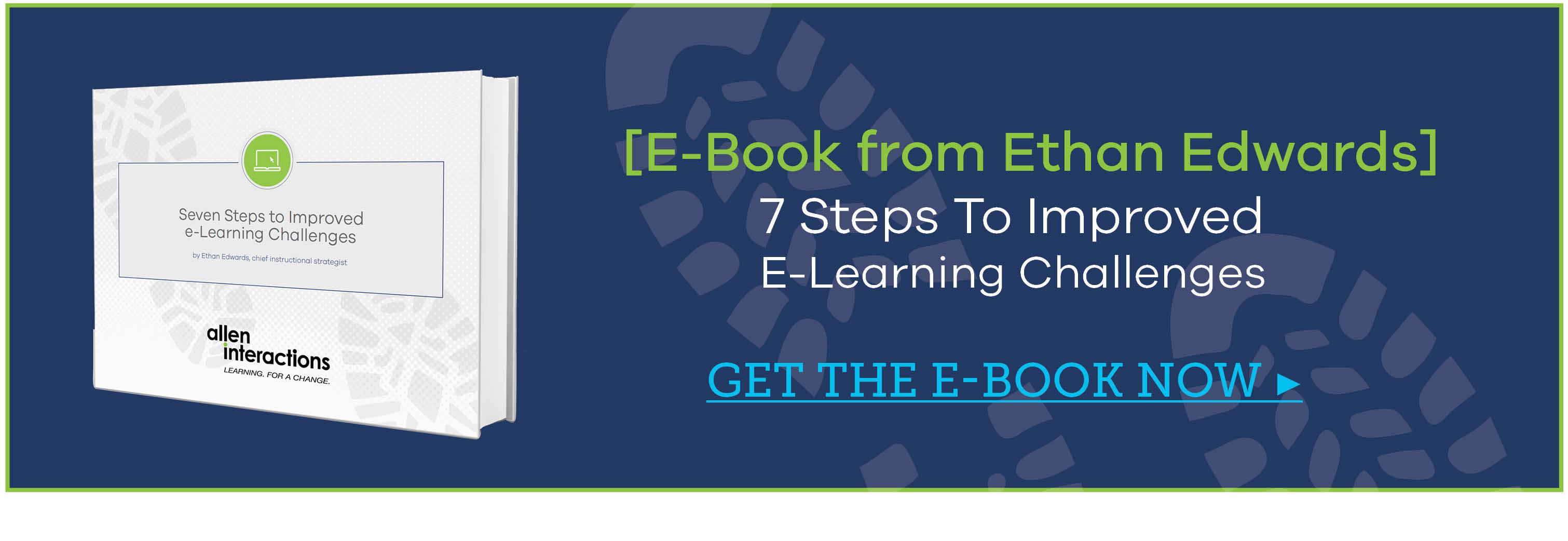Blog
My eLearning Hopes for 2017
By Michael Allen, Chairman & CEO, Allen Interactions eLearning can’t do everything. It can’t detect frustration by observing facial expressions ...


eLearning Design: Assess? When? How?
By Michael Allen | May 18, 2017 | Strategic Consulting | 0 Comments
 By Michael Allen, Chairman & CEO, Allen Interactions
By Michael Allen, Chairman & CEO, Allen Interactions
But elearning is very well equipped to continually assess each learner’s abilities—something an instructor can’t do after class size grows beyond just one or two students. Assessment and the ability to act on assessment data is one of the superb capabilities of elearning technology.

Instruction often follows the legacy format of delivering a block of information and then testing learners to see how much of it was soaked up. A more valuable assessment, of course, is a measure of whether learners can perform at improved levels.
But regardless of what’s measured, if testing comes after instruction has concluded, the common practice I tag as “tell and test,” the assessment has no way to assist individual learners in their progress toward mastery. Whatever they learned, they learned.

One of the easiest ways to improve the effectiveness of instruction for each learner is to reverse the legacy sequence. Find out what level of knowledge and abilities the learner has initially. And then, based on the assessment, determine not only where to start instruction but also which elements, perhaps microlearning elements, to use.
One must hasten to say that just presenting information is hardly teaching or training. So even with the sequence reversed and therefore more powerful, the instruction following an initial assessment should always be based on CCAF Design (context, challenge, activity, and feedback) were possible. And further, because of the information known about the learner, each of the CCAF components would ideally be selected according to the learner’s needs and interests.
But wait. Why just one assessment?
Even with instruction made more capable by the use of an initial assessment, which not only provides critical data for the individualization of the following instruction but also give learners invaluable insight into what they will be learning, assessment doesn’t need to be “once and done.” Assessment should be interleaved with instruction. Again, this is where elearning technology makes possible and practical a powerful instructional approach: continual course correction (nice pun, huh?).
![]()
![]()
Insensitive, non-personalized, one-size-fits-all instruction is what we’re all used to. But with elearning technology, instruction can be adapted to our personal needs. Instead of a straight road through all the content, the best path for each of us probably swerves, loops, and takes shortcuts. To each of us, the best path would look like a straight road, but when compared to what others found optimal, our best path is probably quite curvy.
path would look like a straight road, but when compared to what others found optimal, our best path is probably quite curvy.
Interleaved course correction provides the basis for individualized instruction. Data from each elearning interaction with learners can help determine what should happen next. Does the learner need:
-
Another example?
-
Further explanation?
-
A more detailed demonstration?
-
Practice on simpler exercises?
-
Another similar exercise to work?
-
More difficult exercises?
-
Assistance from an instruction?
Following each interaction, and sometimes within interactions, adaptations can be made in real time. In this approach, instruction and assessment really become one. Learners don’t often, if ever, become aware they’re being tested. Yet they’re always being tested.
Not only does such individualized instruction keep learners highly engaged, each instructional event selected and/or adapted for them makes the very best use of their time. Overall, training time is shortened and performance outcomes can be assured.
Click Tweet Below to Share:

About the Author: Michael Allen
Go to https://www.alleninteractions.com/bio/dr-michael-allen Michael W. Allen, PhD, has been a pioneer in the e-learning industry since 1970. For decades, Allen has concentrated on defining unique methods of instructional design and development that provide meaningful, memorable, and motivational learning experiences through enhanced cognitive interactivity. He developed the advanced design and development approaches we have used at Allen Interactions for the past three decades, including CCAF-based design and the SAM process for iterative, collaborative development. Michael is a prolific writer, sought-after conference speaker, and recognized industry leader, having written or edited nine books on designing effective e-learning solutions, including his latest edition: Michael Allen’s Guide to e-Learning. He has contributed chapters to textbooks and handbooks published by leading authors and associations.
Comments
Would you like to leave a comment?
Related Blog Posts

By: Michael Allen | Jan, 2017
Category: Custom Learning, Strategic Consulting

Blog
Why is Good eLearning So Rare?
By Michael Allen, Chairman & CEO, Allen Interactions eLearning can’t do everything. It can’t detect frustration by observing facial expressions ...
By: Michael Allen | May, 2017
Category: Custom Learning, Dr. Michael Allen

Blog
We're in this together
By Michael Allen, Chairman & CEO, Allen Interactions eLearning can’t do everything. It can’t detect frustration by observing facial expressions ...
By: Michael Allen | Mar, 2020
Category: Strategic Consulting

